Impact of the Spatiotemporal Relationship Between Blast Source and Protected Area on Wave Arrival Sequence and Vibration Control Methods in Bench Blasting
Abstract
1. Introduction
2. Vibration Control Methods
2.1. Principle for Calculating the Vibration Wave Arrival Time at the Monitoring Point (Wave Arrival Time)
2.2. Problems That Can Be Solved by Analyzing to Wave Arrival Time Sequence and Their Positive Implications
2.3. Single-Shot Vibration Waveform Reconstruction and Multi-Hole Vibration Superposition Method
- (1)
- Determination of the scaling factor for vibration curves at arbitrary blast hole locations.
- (2)
- Reconstruction method for the single-shot vibration curve at arbitrary locations.
- (3)
- Method for the superposition of vibration waveforms in multi-hole blasting.
3. Field Test Analysis and Delay Adjustment Under Vibration Control
3.1. Engineering Background
3.2. Vibration Wave Arrival Time Sequence Analysis for Single Monitoring Point and Delay Adjustment
3.3. Vibration Wave Arrival Time Sequence Analysis for Multiple Monitoring Points Surrounding the Blast Area and Delay Time Adjustment
4. Conclusions
- (1)
- Based on the spatiotemporal relationship between blast holes and monitoring points, a computational method is established to determine the arrival time sequences of vibration waves from any blast hole to different monitoring points. The vibration induced by multi-hole blasting is the result of superimposing single-hole vibration waves according to their arrival time sequences. As the arrival time sequence varies with the location of the monitoring point, the optimal delay time for a specific location often fails to meet the vibration control requirements at other locations. The vibration control method proposed in this study, which builds upon the original delay design, achieves precise vibration control by separating vibration waves during clustering arrival periods while maintaining the fragmentation effectiveness of the original blasting scheme.
- (2)
- For vibration control at a single monitoring point, the number of wave arrivals within each fixed time interval is statistically analyzed based on the principle of wave arrival time sequence calculation. By identifying time intervals with a high number of simultaneous wave arrivals and their corresponding blast holes, the delay times of these holes are adjusted to effectively reduce the number of arriving vibration waves within these intervals, thereby significantly lowering the high-probability vibration hazard. Taking Monitoring Point B1 as an example in Section 3.2, within the time range of 1800 to 2670 ms, the number of vibration waves arriving at the monitoring point simultaneously after the adjustment decreased from 5 to less than 3. The peak value of the vibration decreased by more than 10.55%, and the RMS value decreased by 17.86%.
- (3)
- For vibration control across multiple monitoring points, the maximum number of simultaneous wave arrivals at each monitoring point is statistically analyzed based on the principle of wave arrival time sequence calculation. A precise identification method for high-probability vibration hazard locations around the blasting area is proposed, providing critical targets for vibration control. By identifying time intervals with a high number of wave arrivals and their corresponding blast holes at these locations, the number of arriving vibration waves within these intervals is sequentially reduced, successfully eliminating vibration hazards at these points. In Section 3.3, a total of 7 locations with a high probability of vibration hazards in 2 directions were identified around the experimental blasting area. Among these, the maximum number of vibration waves arriving simultaneously reached 6. Taking Monitoring Point A1 as an example, after the adjustment, all the locations with a high probability of vibration hazards were eliminated. The number of locations where the number of simultaneously arriving waves was 5 decreased by 88.57%. Following the delay adjustment, the peak superimposed vibration velocity was reduced by 14.05%, while the root mean square (RMS) velocity within the monitoring window (1800–3320 ms) decreased by 18.33%, corresponding to a 1.76 dB reduction and a 33.31% attenuation in vibrational energy. Effective control of blasting vibration in all directions around the blasting area was realized.
Author Contributions
Funding
Institutional Review Board Statement
Informed Consent Statement
Data Availability Statement
Acknowledgments
Conflicts of Interest
References
- Leng, Z.; Fan, Y.; Gao, Q.; Hu, Y. Evaluation and optimization of blasting approaches to reducing oversize boulders and toes in open-pit mine. Int. J. Min. Sci. Technol. 2020, 30, 373–380. [Google Scholar] [CrossRef]
- Ozdemir, B.; Kumral, M. A system-wide approach to minimize the operational cost of bench production in open-cast mining operations. Int. J. Coal. Sci. Technol. 2019, 6, 84–94. [Google Scholar] [CrossRef]
- Kozan, E.; Liu, S. An operational-level multi-stage mine production timetabling model for optimally synchronising drilling, blasting and excavating operations. Int. J. Min. Reclam. Environ. 2017, 31, 457–474. [Google Scholar] [CrossRef]
- Dumakor-Dupey, N.; Arya, S.; Jha, A. Advances in blast-induced impact prediction—A review of machine learning applications. Minerals 2021, 11, 601. [Google Scholar] [CrossRef]
- Cardu, M.; Coragliotto, D.; Oreste, P. Analysis of predictor equations for determining the blast-induced vibration in rock blasting. Int. J. Min. Sci. Technol. 2019, 29, 905–915. [Google Scholar] [CrossRef]
- Nguyen, H.; Bui, X.; Tran, Q.; Nguyen, H.; Nguyen, D.; Hoa, L.; Le, Q. Prediction of ground vibration intensity in mine blasting using the novel hybrid MARS–PSO–MLP model. Eng. Comput. 2022, 38 (Suppl. 5), 4007–4025. [Google Scholar] [CrossRef]
- Yan, W.; Tham, L.; Yuen, K. Reliability of empirical relation on the attenuation of blast-induced vibrations. Int. J. Min. Sci. Technol. 2013, 59, 160–165. [Google Scholar] [CrossRef]
- Torres, V.; Silveira, L.; Lopes, P.; de Lima, H. Assessing and controlling of bench blasting-induced vibrations to minimize impacts to a neighboring community. J. Cleaner Prod. 2018, 187, 514–524. [Google Scholar] [CrossRef]
- Tian, X.; Song, Z.; Wang, J. Study on the propagation law of tunnel blasting vibration in stratum and blasting vibration reduction technology. Soil Dyn. Earthquake Eng. 2019, 126, 105813. [Google Scholar] [CrossRef]
- Yang, J.; Jiyong, C.; Chi, Y. Discussion on blasting vibration monitoring for rock damage control in rock slope excavation. Earthq. Eng. Eng. Vib. 2022, 21, 53–65. [Google Scholar]
- Guo, J.; Zhao, P.; Li, P. Prediction and optimization of blasting-induced ground vibration in open-pit mines using intelligent algorithms. Appl. Sci. 2023, 13, 7166. [Google Scholar] [CrossRef]
- Azizabadi, H.; Mansouri, H.; Fouché, O. Coupling of two methods, waveform superposition and numerical to model blast vibration effect on slope stability in jointed rock masses. Comput Geotech. 2014, 61, 42–49. [Google Scholar] [CrossRef]
- Mansouri, H.; EBRAHIMI, F. Blast vibration modeling using linear superposition method. J. Min. Environ. 2015, 125–140. [Google Scholar]
- Singh, C.; Agrawal, H.; Mishra, A. Frequency channeling: A concept to increase the frequency and control the PPV of blast-induced ground vibration waves in multi-hole blast in a surface mine. Bull. Eng. Geol. Environ. 2021, 80, 8009–8019. [Google Scholar] [CrossRef]
- Kumar, S.; Mishra, A.; Choudhary, B. Prediction of back break in blasting using random decision trees. Eng. Comput. 2022, 38 (Suppl. 2), 1185–1191. [Google Scholar] [CrossRef]
- Agrawal, H.; Mishra, A. An innovative technique of simplified signature hole analysis for prediction of blast-induced ground vibration of multi-hole production blast: An empirical analysis. Nat. Hazards. 2020, 100, 111–132. [Google Scholar] [CrossRef]
- Singh, C.; Agrawal, H.; Mishra, A.; Singh, P. Reducing environmental hazards of blasting using electronic detonators in a large opencast coal project-a case study. J. Mines. Met. Fuels. 2019, 67, 345–350. [Google Scholar]
- Silva, J.; Li, L.; Gernand, J. Reliability analysis for mine blast performance based on delay type and firing time. Int. J. Min. Sci. Technol. 2018, 28, 195–204. [Google Scholar] [CrossRef]
- Jayasinghe, B.; Zhao, Z.; Chee, A.; Zhou, H.; Gui, Y. Attenuation of rock blasting induced ground vibration in rock-soil interface. J. Rock. Mech. Geotech. 2019, 11, 770–778. [Google Scholar] [CrossRef]
- Garai, D.; Agrawal, H.; Mishra, A.; Kumar, S. Influence of initiation system on blast-induced ground vibration using random forest algorithm, artificial neural network, and scaled distance analysis. Math. Model. Eng. Probl. 2018, 5, 418–426. [Google Scholar] [CrossRef]
- Yu, C.; Yue, H.; Li, H.; Zuo, H.; Deng, S.; Liu, B. Study on the attenuation parameters of blasting vibration velocity in jointed rock masses. B. Eng. Geol. Environ. 2019, 78, 5357–5368. [Google Scholar] [CrossRef]
- Yang, N.; Zhang, L. Blasting vibration waveform prediction method based on superposition principle. Explo. Shock. Wave. 2012, 32, 84–90. (In Chinese) [Google Scholar]
- Gou, Y.; Shi, X.; Qiu, X.; Huo, X.; Yu, Z. Assessment of induced vibrations derived from the wave superposition in time-delay blasts. Int. J. Rock. Mech. Min. 2021, 144, 104814. [Google Scholar] [CrossRef]
- Garai, D.; Agrawal, H.; Mishra, A. Impact of orientation of blast initiation on ground vibrations. J. Rock. Mech. Geotech. 2023, 15, 255–261. [Google Scholar] [CrossRef]
- Segarra, P.; López, L.; Sanchidrián, J. Uncertainty in measurements of vibrations from blasting. Rock. Mech. Rock. Eng. 2012, 45, 1119–1126. [Google Scholar] [CrossRef]
- Yang, R.; Kay, D.; Kim, G. Case examples of sensor coupling effect on blast vibration measurement and charge weight scaling plot. In Proceedings of the ISEE Proceedings 40th Ann. Conference on Explosives and Blasting Technique, Denver, CO, USA, 9–12 February 2014. [Google Scholar]
- Birch, W.; Farnfield, R.; Hosein, S. Blast vibration monitoring & calibration in the 21st century. In Proceedings of the ISEE Proceedings 40th Ann. Conference on Explosives and Blasting Technique, Denver, CO, USA, 9–12 February 2014. [Google Scholar]
- Bui, X.; Nguyen, H.; Tran, Q.; Nguyen, D.; Bui, H. Predicting ground vibrations due to mine blasting using a novel artificial neural network-based cuckoo search optimization. Nat. Resour. Res. 2021, 30, 2663–2685. [Google Scholar] [CrossRef]
- Rodríguez, R.; de Marina, L.; Bascompta, M.; Lombardía, C. Determination of the ground vibration attenuation law from a single blast: A particular case of trench blasting. J. Rock. Mech. Geotech. Eng. 2021, 13, 1182–1192. [Google Scholar] [CrossRef]
- Ongen, T.; Karakus, D.; Konak, G.; Onur, A.H. Assessment of blast-induced vibration using various estimation models. J. Afr. Earth. Sci. 2018, 145, 267–273. [Google Scholar] [CrossRef]
- Shi, X.; Chen, S. Delay time optimization in blasting operations for mitigating the vibration-effects on final pit walls’ stability. Soil Dyn. Earthquake Eng. 2011, 31, 1154–1158. [Google Scholar] [CrossRef]
- Rezaeineshat, A.; Monjezi, M.; Mehrdanesh, A. Optimization of blasting design in open pit limestone mines with the aim of reducing ground vibration using robust techniques. Geomech. Geophys. Geo-Energ. Geo-Resour. 2020, 6, 40. [Google Scholar] [CrossRef]
- Li, P.; Lu, W.; Wu, X.; Chen, M.; Yan, P.; Hu, Y. Spectral prediction and control of blast vibrations during the excavation of high dam abutment slopes with millisecond-delay blasting. Soil Dyn. Earthquake Eng. 2017, 94, 116–124. [Google Scholar] [CrossRef]
- Li, S.; Liang, S.; Lu, J. Study on internal vibration law and vibration reduction of xiaoxiku tunnel blasting. Geofluids 2022, 2022, 7650784. [Google Scholar] [CrossRef]
- Aldas, G.; Ecevitoglu, B. Waveform analysis in mitigation of blast-induced vibrations. J. Appl. Geophys. 2008, 66, 25–30. [Google Scholar] [CrossRef]
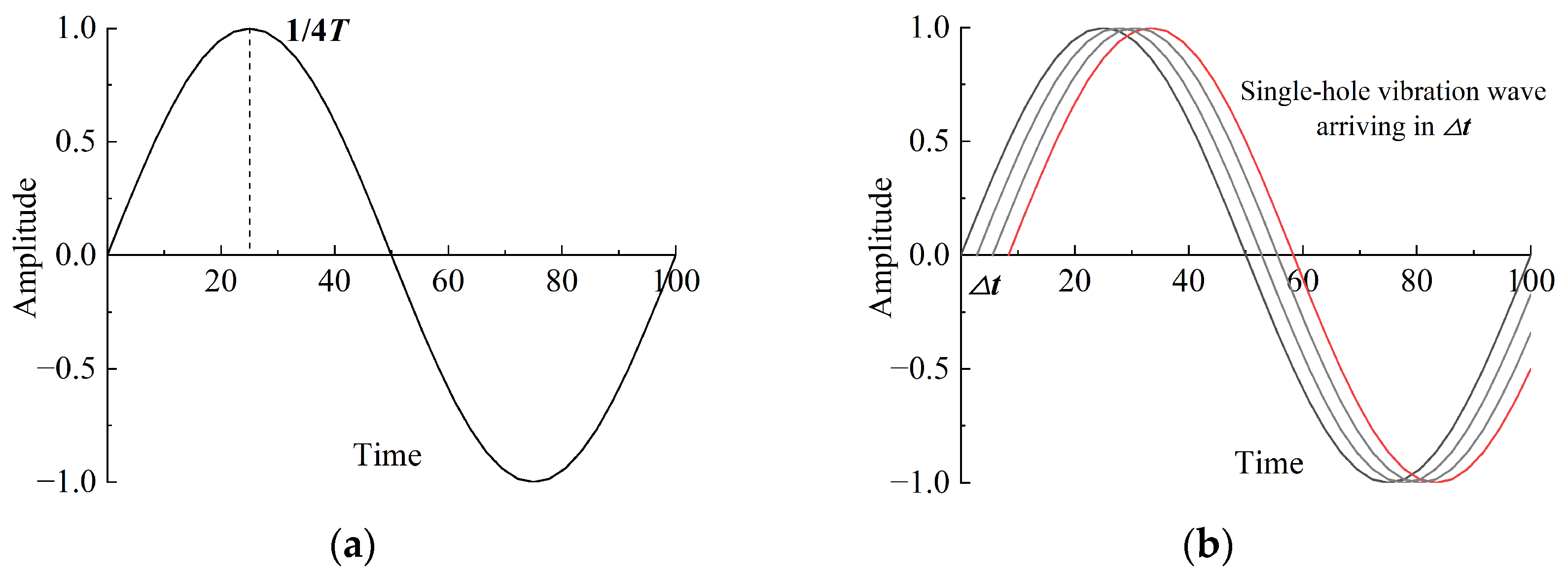
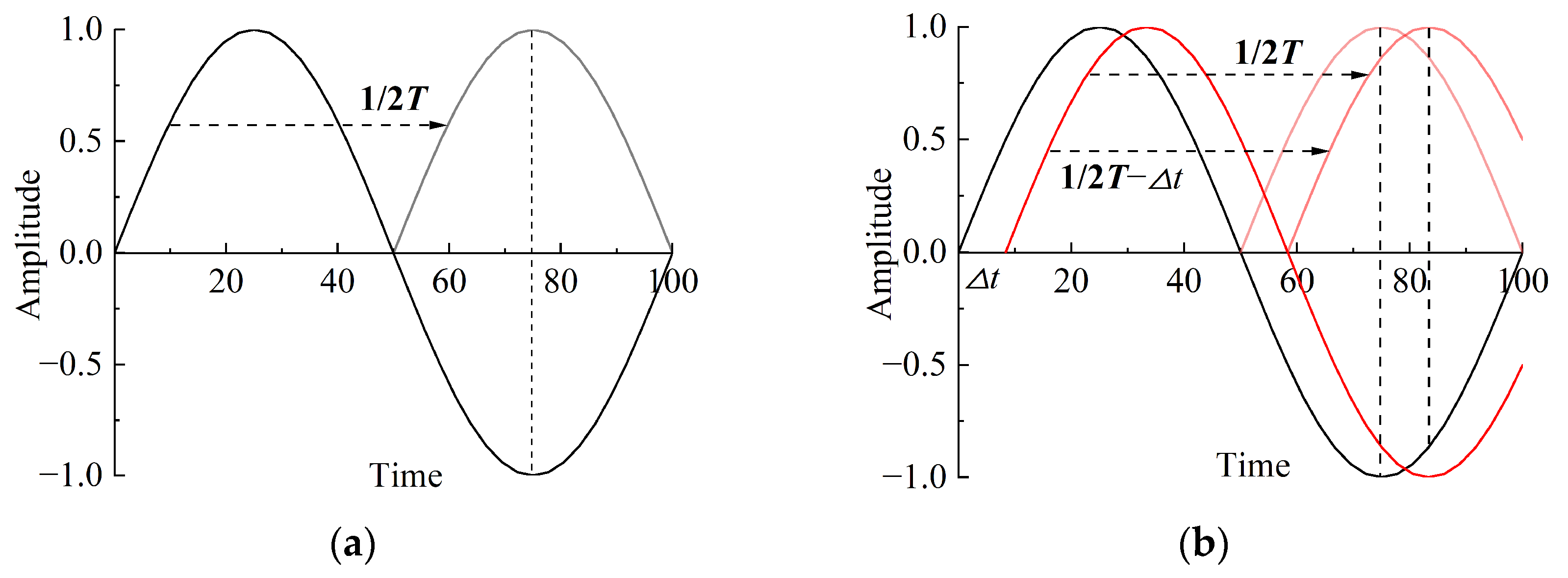

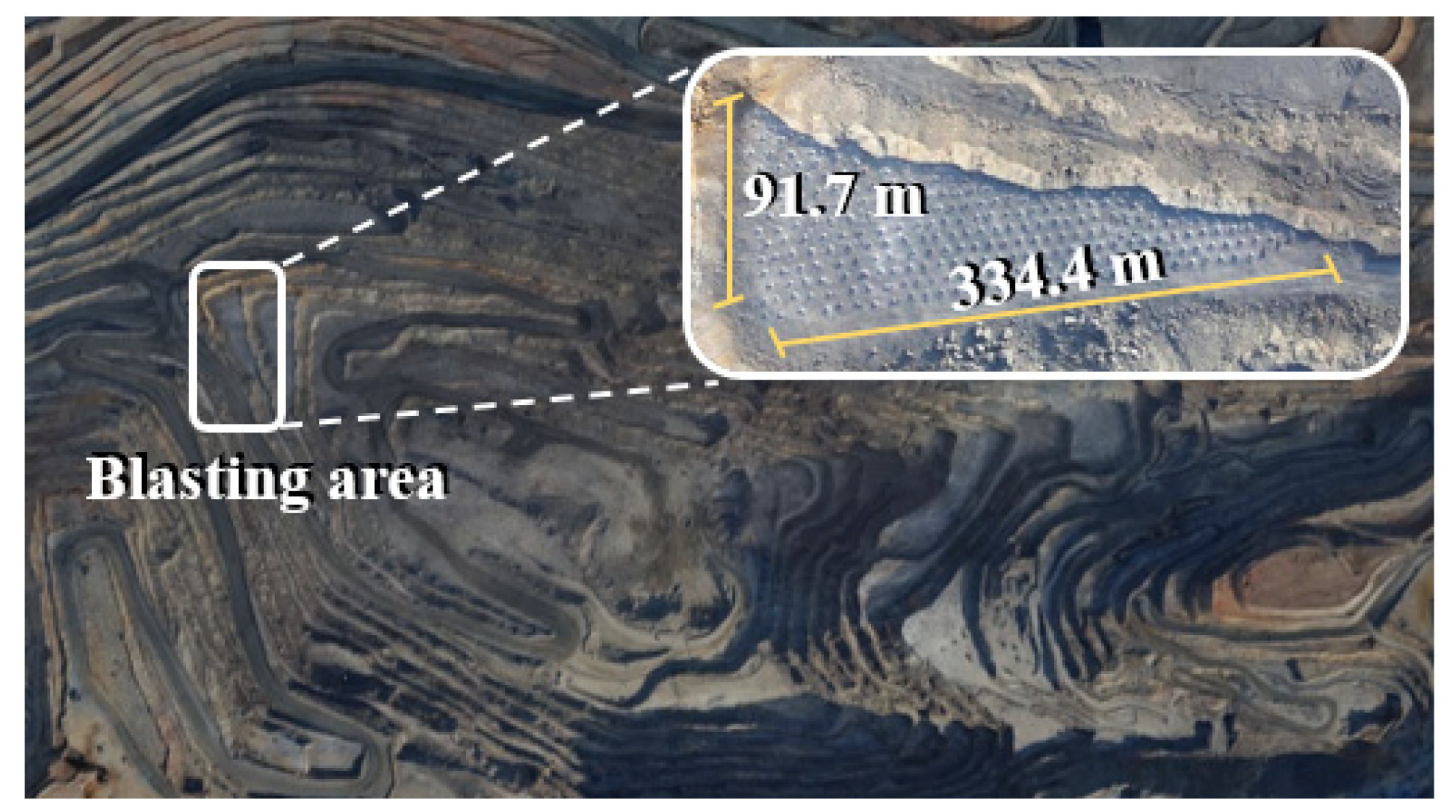
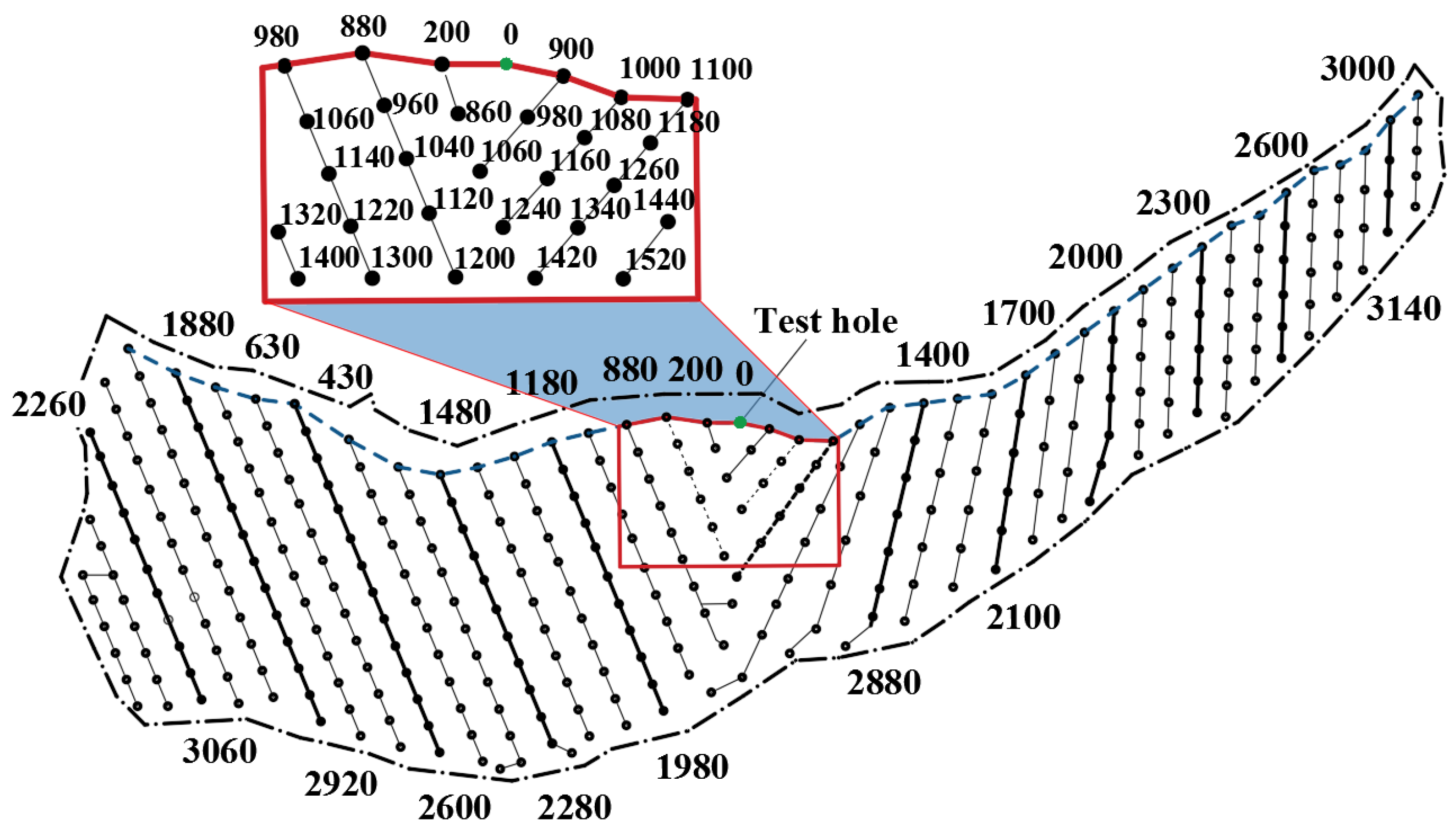



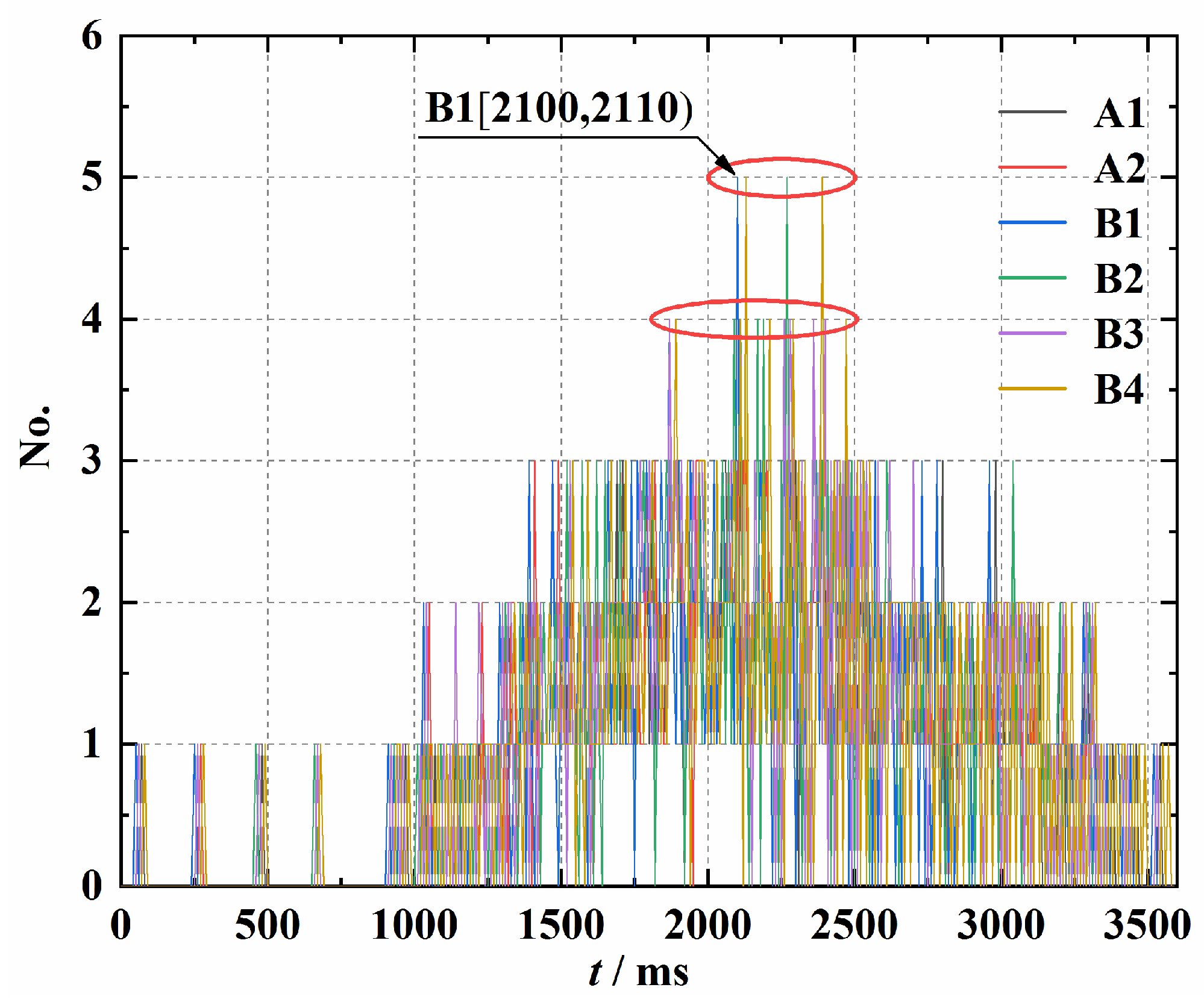

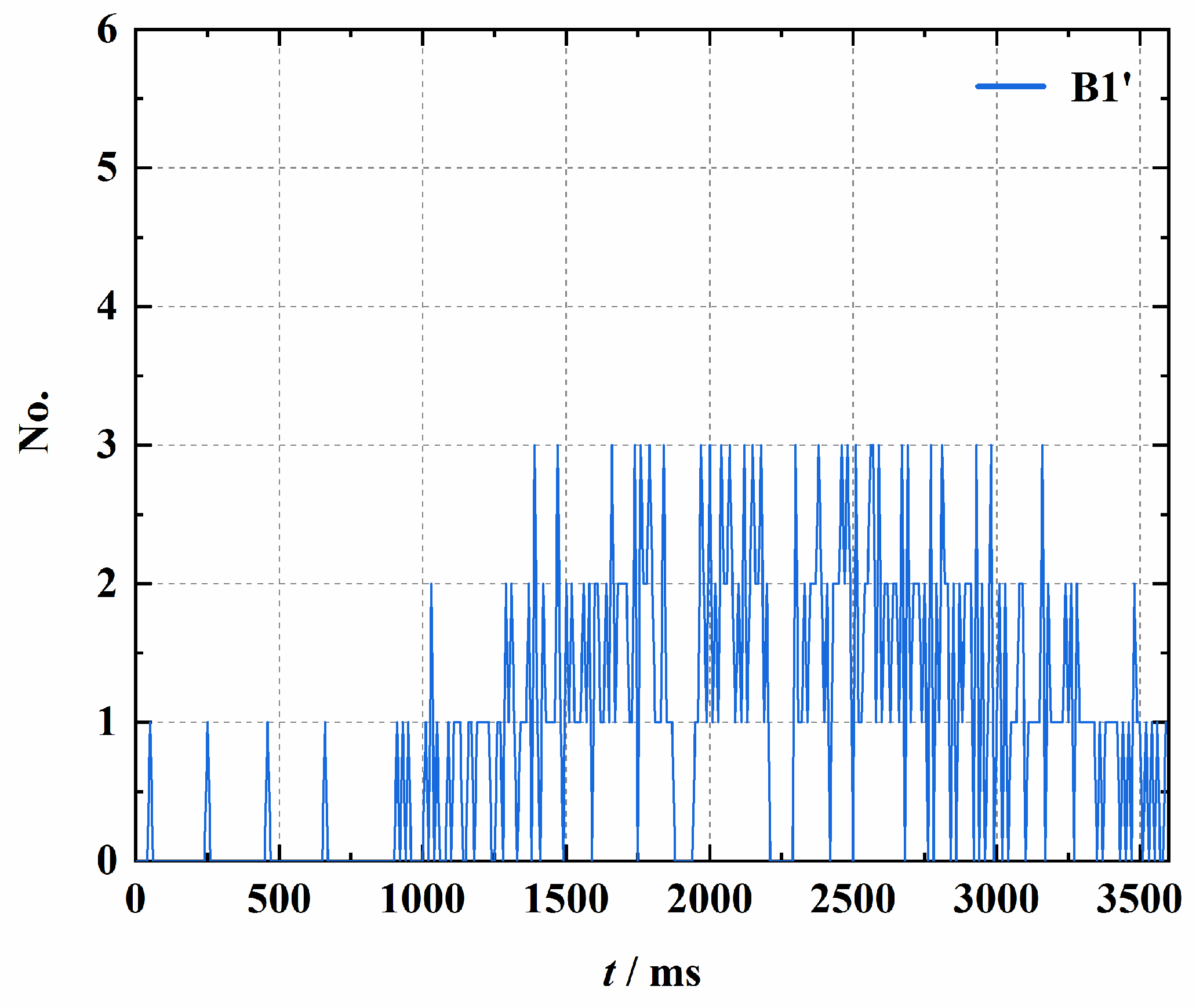
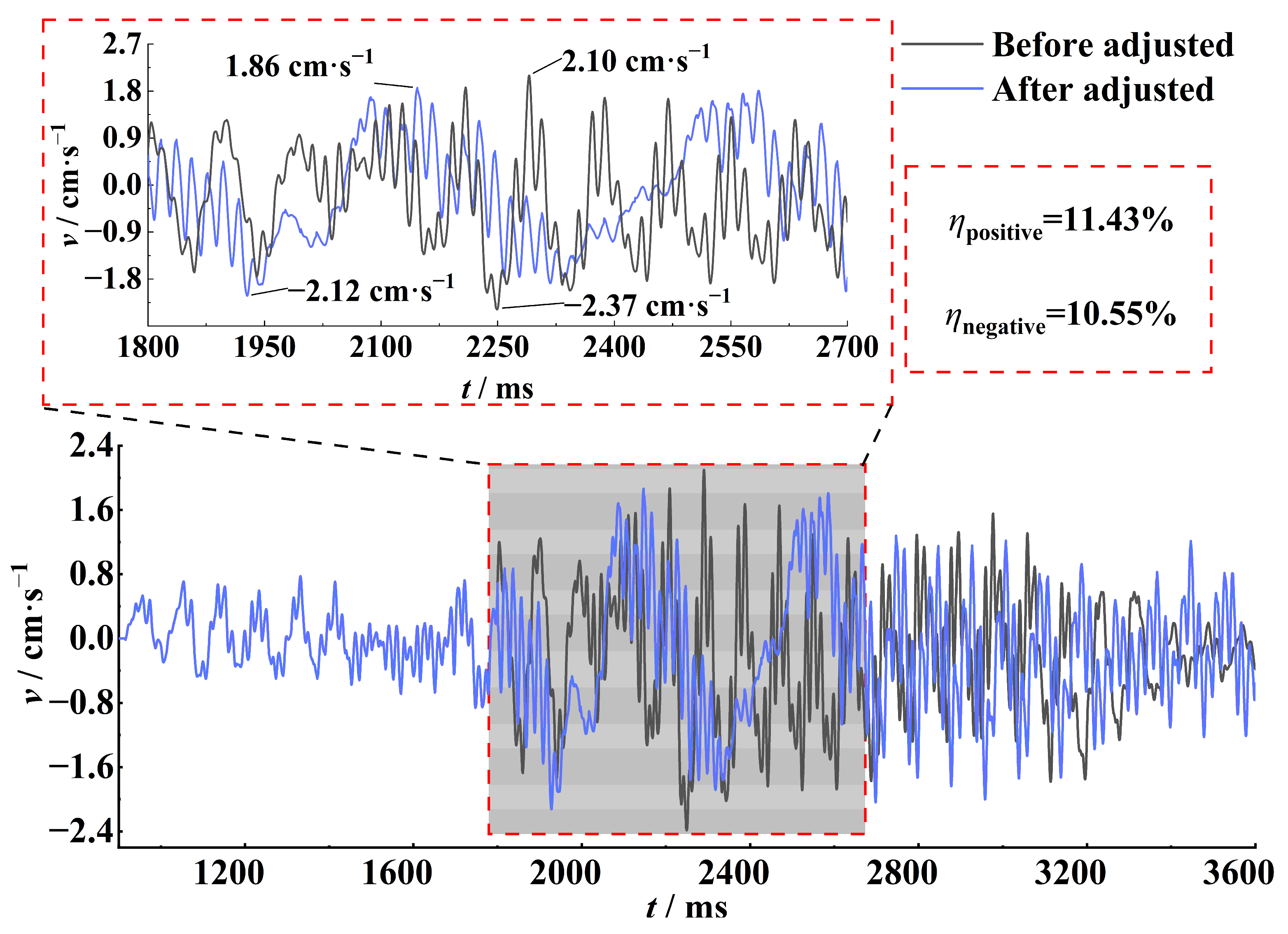
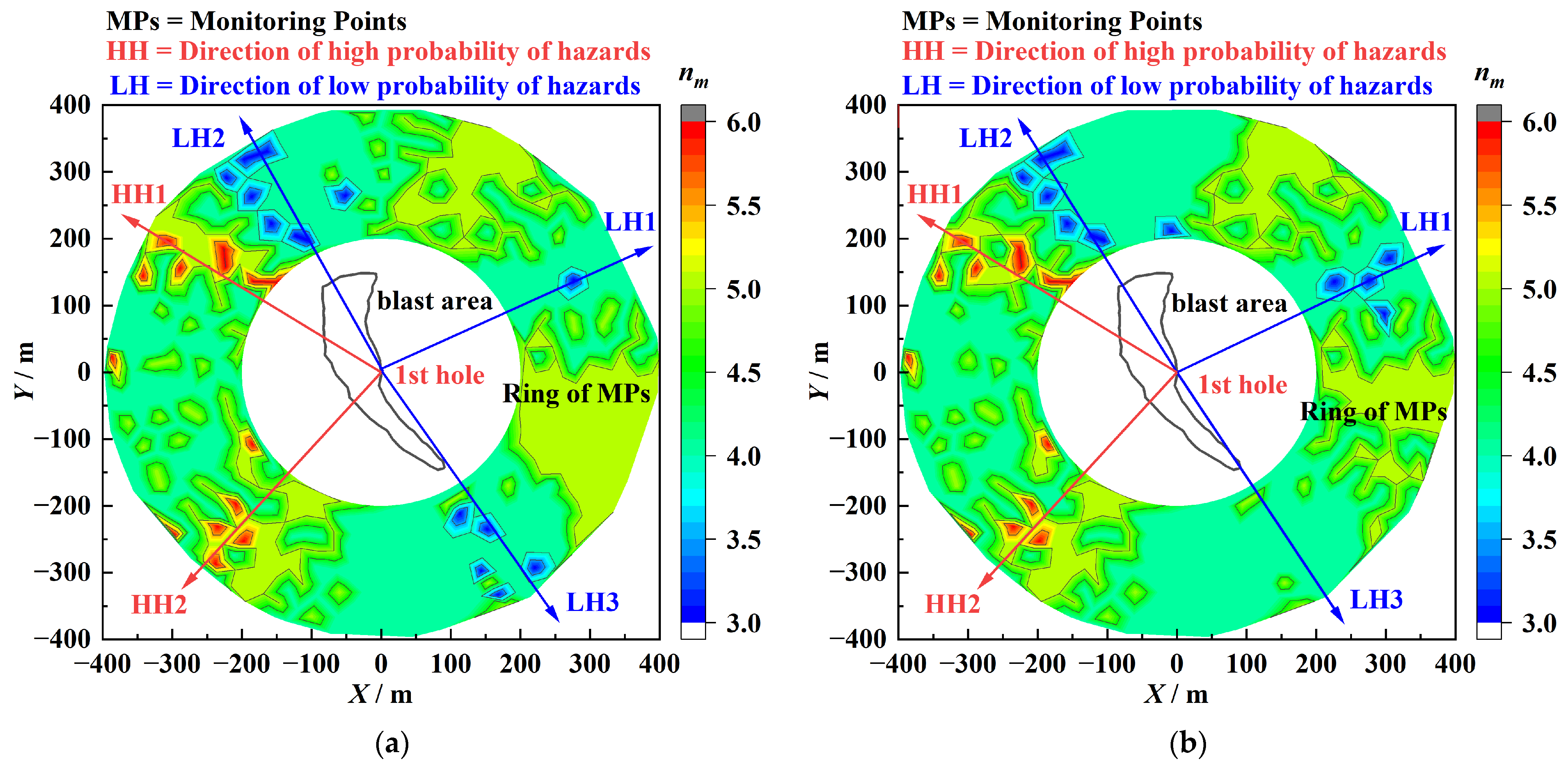
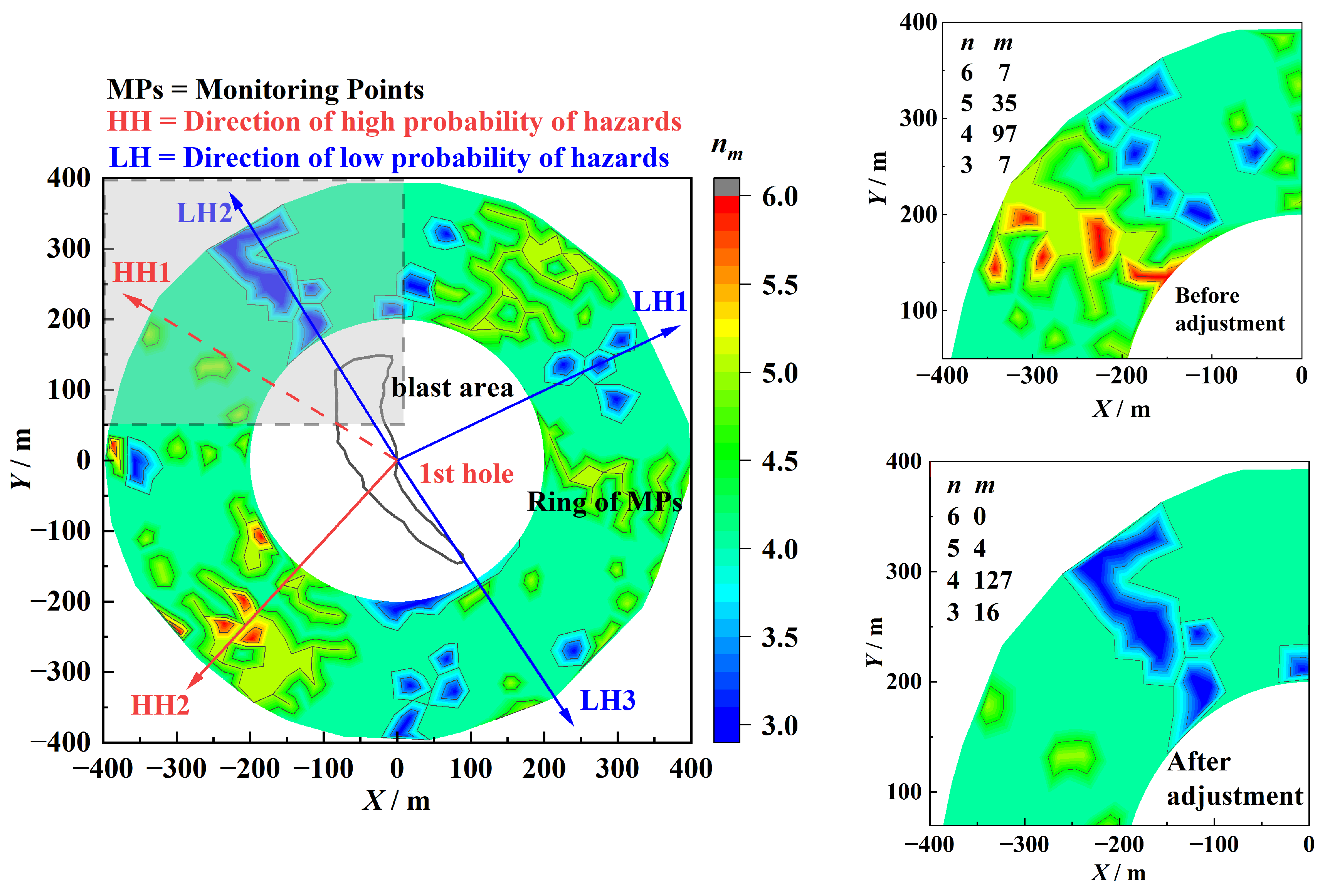
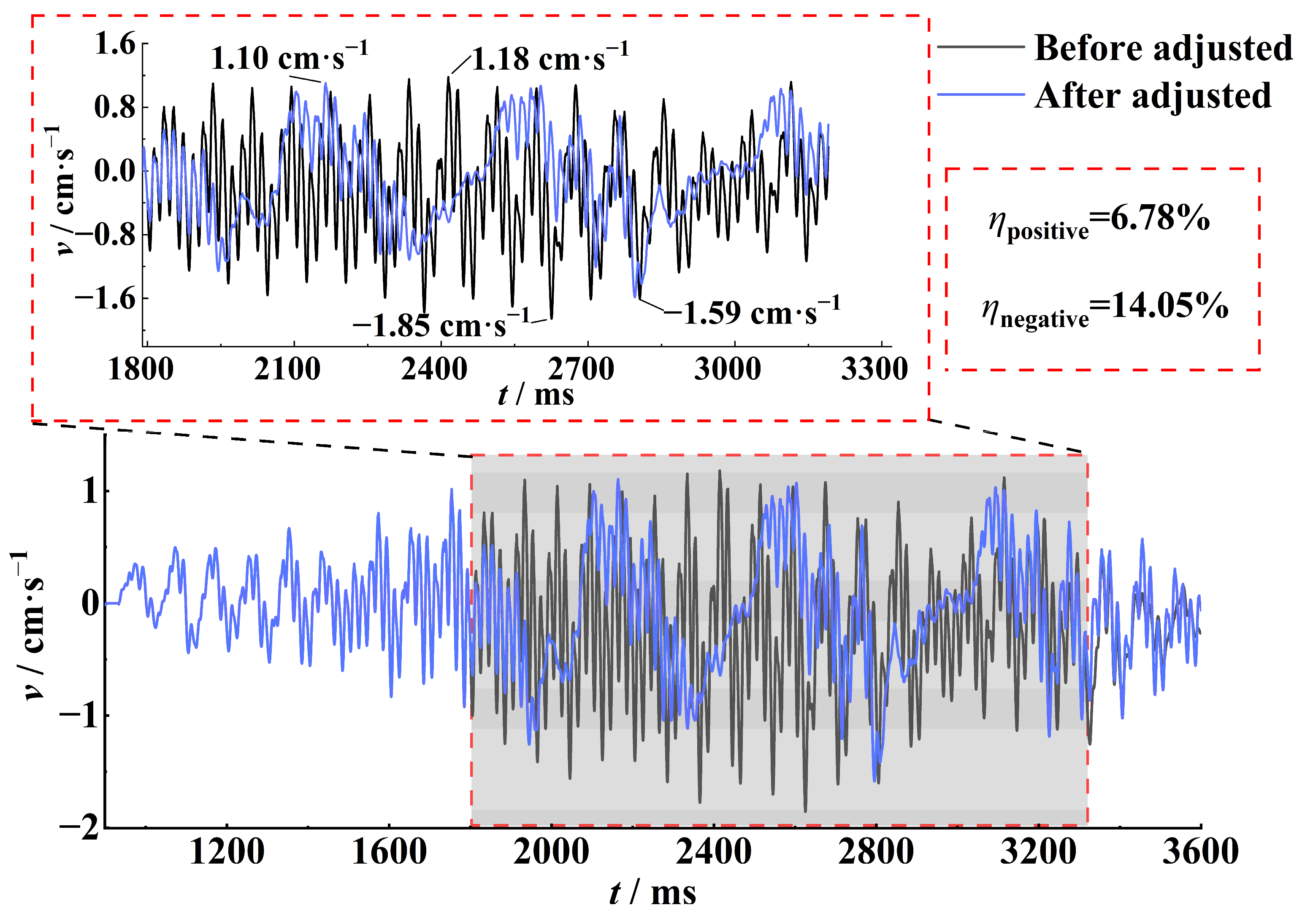
Disclaimer/Publisher’s Note: The statements, opinions and data contained in all publications are solely those of the individual author(s) and contributor(s) and not of MDPI and/or the editor(s). MDPI and/or the editor(s) disclaim responsibility for any injury to people or property resulting from any ideas, methods, instructions or products referred to in the content. |
© 2025 by the authors. Licensee MDPI, Basel, Switzerland. This article is an open access article distributed under the terms and conditions of the Creative Commons Attribution (CC BY) license (https://creativecommons.org/licenses/by/4.0/).
Share and Cite
Wang, S.; Wu, H.; Gong, M.; Wu, X. Impact of the Spatiotemporal Relationship Between Blast Source and Protected Area on Wave Arrival Sequence and Vibration Control Methods in Bench Blasting. Appl. Sci. 2025, 15, 4641. https://doi.org/10.3390/app15094641
Wang S, Wu H, Gong M, Wu X. Impact of the Spatiotemporal Relationship Between Blast Source and Protected Area on Wave Arrival Sequence and Vibration Control Methods in Bench Blasting. Applied Sciences. 2025; 15(9):4641. https://doi.org/10.3390/app15094641
Chicago/Turabian StyleWang, Sijie, Haojun Wu, Min Gong, and Xiaodong Wu. 2025. "Impact of the Spatiotemporal Relationship Between Blast Source and Protected Area on Wave Arrival Sequence and Vibration Control Methods in Bench Blasting" Applied Sciences 15, no. 9: 4641. https://doi.org/10.3390/app15094641
APA StyleWang, S., Wu, H., Gong, M., & Wu, X. (2025). Impact of the Spatiotemporal Relationship Between Blast Source and Protected Area on Wave Arrival Sequence and Vibration Control Methods in Bench Blasting. Applied Sciences, 15(9), 4641. https://doi.org/10.3390/app15094641





